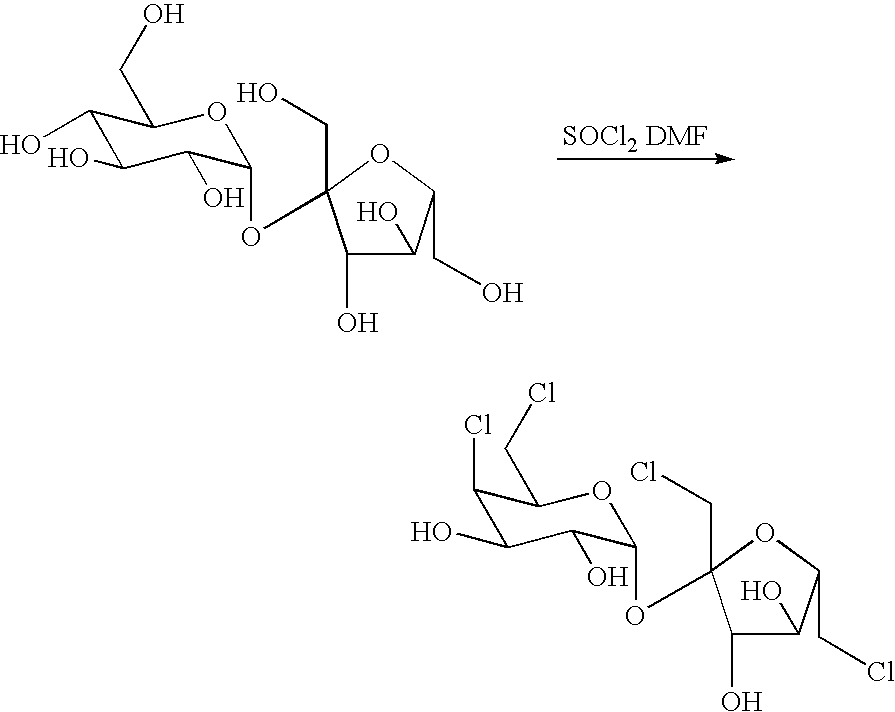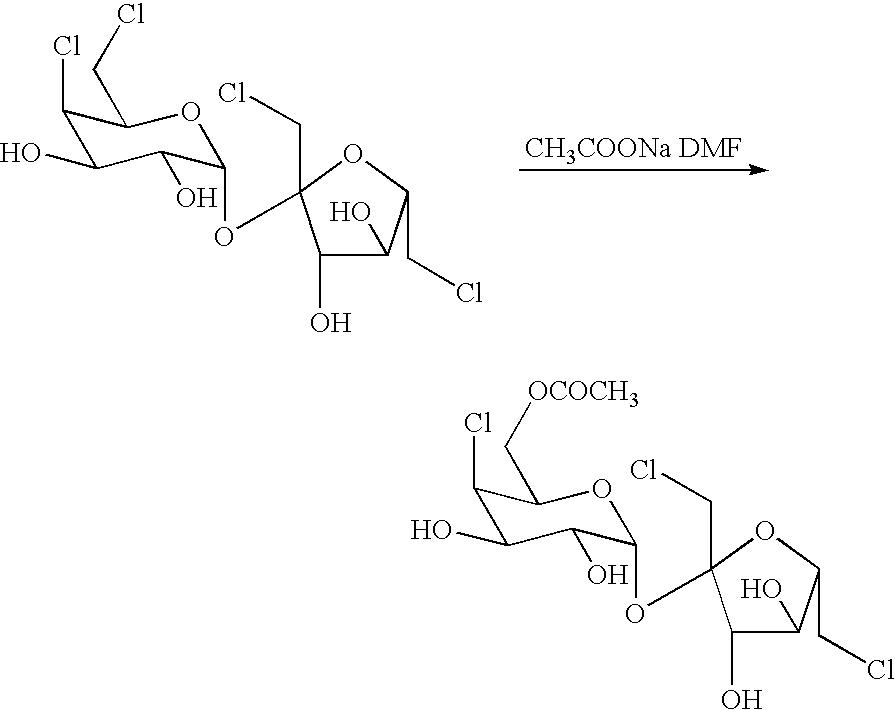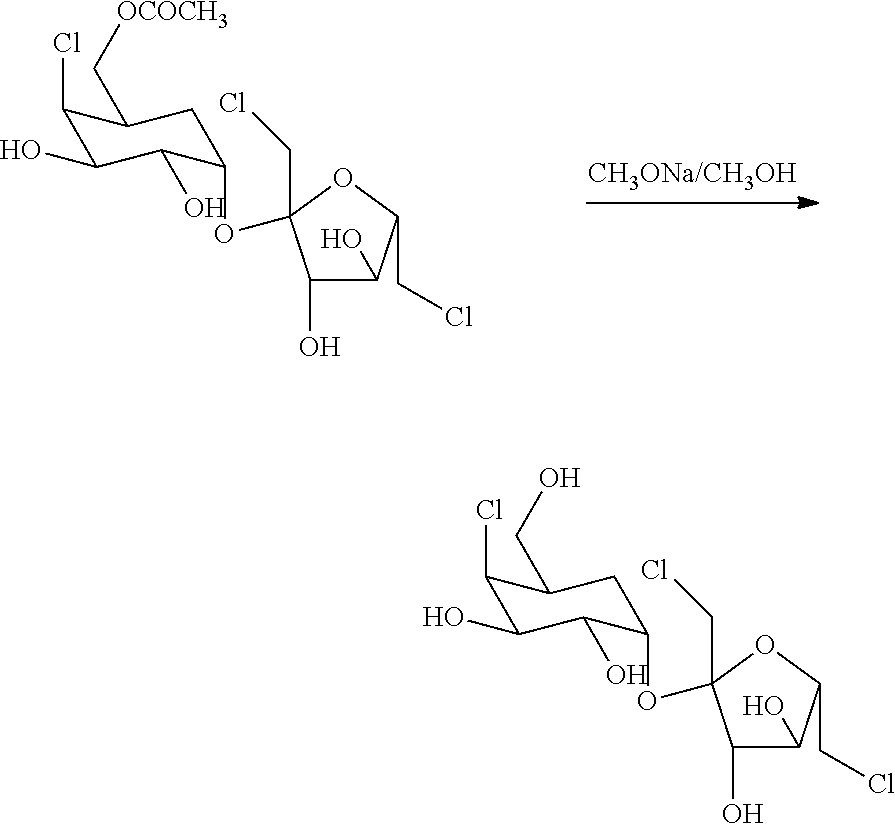Process for the preparation of sucralose
a technology of sucralose and sucralose, which is applied in the field of chemical synthesis, can solve the problems of low yield, further complicated synthesis, and widespread us
- Summary
- Abstract
- Description
- Claims
- Application Information
AI Technical Summary
Benefits of technology
Problems solved by technology
Method used
Image
Examples
example 1
Preparation of 4,6,1′, 6′-tetrachloro-4,6,1′, 6′-tetradeoxylgalactosurose
[0031]A 500mL, four-neck, round-bottom flask, equipped with mechanical stirrer, thermometer, addition funnel, and reflux condenser topped with an argon inlet, was charged with 25g of sucrose and 240g of DMF. This solution was cooled down to −10°, and then added dropwise over 1h with 78g of thionyl chloride. During the addition, the precipitate was formed. The slurry became easier to stir as the temperature of the reaction mixture increased. After that, the solution was heated to 90° over a period of 2h, heated to 110° over another period of 2h, and then held at this temperature for 1h. Next, the reaction mixture was cooled down to 0° again, stirred at this temperature for 15min and then added 100mL ice cold 4N NaOH with vigorous stirring that the pH value was about 9 after the addition. Then, the reaction mixture keeps vigorous stirring and then adds certain amount of glacial acetic acid to adjust the pH value ...
example 2
Preparation of 4,6,1′, 6′-tetrachloro-4,6,1′, 6′-tetradeoxylgalactosurose
[0032]144g of Dimethyl formamide(DMF) was added dropwise 78g of thionyl chloride at −10° with vigorously stirring over a period of 1h, and the precipitate was observed. The reaction mixture was held at this temperature for 30min, then added 25g of sucrose which dissolving in 96g of DMF. After completely the addition, the reaction mixture was then heated to 90° over a period of 2h, heated to 110° over another period of 2h, and held at this temperature for 1h. Next, the reaction mixture was cooled down to 0° , stirred at this temperature for 15min and then added 100 mL ice cold 4N NaOH with vigorous stirring that the pH value was about 9 after the addition. Then, the reaction mixture was vigorously stirred to adjust pH value to 7 by adding certain amount of glacial acetic acid. Afterward, around 300mL ethyl acetate was added and the organic layer was separated. The aqueous layer was further extracted with ethyl a...
example 3
Preparation of Sucralose-6-acetate
[0033]The solution of 25.8g of 4,6,1′, 6′ tetrachloro-4,6,1′, 6′-tetradeoxylgalactosurose and 80g of DMF was added by 6g of anhydrous sodium acetate, and stirred at 50° for 6h under nitrogen condition. The reaction mixture was then added 30mL water, and then extracted by 300mL ethyl acetate. The organic layer was separated afterward. The aqueous layer was further extracted with ethyl acetate (2×200mL). Afterward, each extracted organic solvent was combined together and then treated with about 3g of activated carbon for about 30min at ambient temperature. The slurry was filtered and the cake washed with ethyl acetate. The resulting filtrate was evaporated and concentrated under vacuum condition. The residue was dried in high-vacuum condition and to give 21g crude sucralose-6-acetate. The crude was re-crystallized in 30g water to afford 15.8g sucralose-6-acetate.
PUM
| Property | Measurement | Unit |
|---|---|---|
| aprotic polar | aaaaa | aaaaa |
| temperature | aaaaa | aaaaa |
| stability | aaaaa | aaaaa |
Abstract
Description
Claims
Application Information
 Login to View More
Login to View More - R&D
- Intellectual Property
- Life Sciences
- Materials
- Tech Scout
- Unparalleled Data Quality
- Higher Quality Content
- 60% Fewer Hallucinations
Browse by: Latest US Patents, China's latest patents, Technical Efficacy Thesaurus, Application Domain, Technology Topic, Popular Technical Reports.
© 2025 PatSnap. All rights reserved.Legal|Privacy policy|Modern Slavery Act Transparency Statement|Sitemap|About US| Contact US: help@patsnap.com



